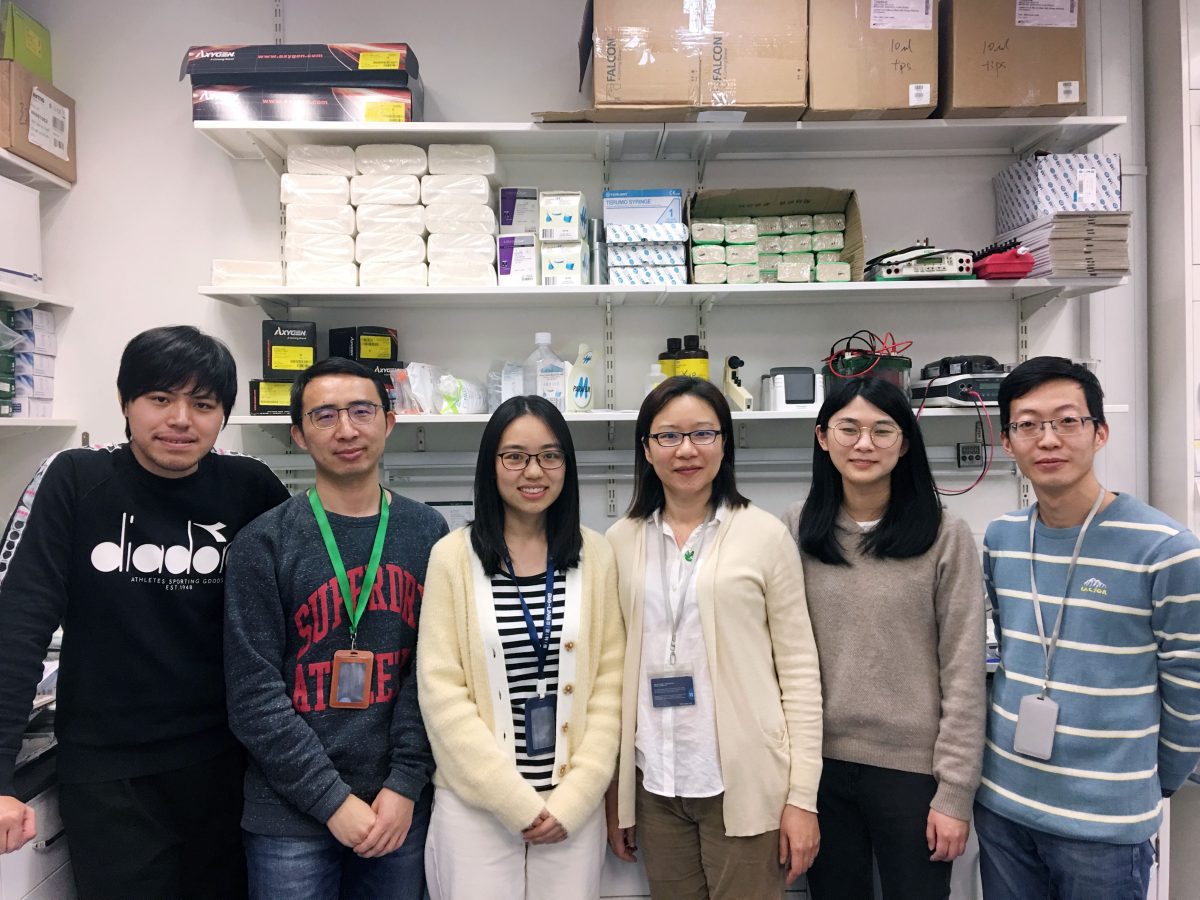News Express: UM research team creates breakthrough in cell replacement therapies for diabetes
新聞快訊:澳大研究團隊最新突破助糖尿病細胞治療


柯潔(右二)、謝瑞瑜(右三)、吳欣蔚(右四)和藍清平(左一)
Xie Ruiyu (3rd from right), Wu Xinwei (4th from right), Ke Jie (2nd from right), and Lan Qingping (1st from left)
澳大研究團隊最新突破助糖尿病細胞治療
澳門大學健康科學學院副教授謝瑞瑜的研究團隊在胰腺β細胞分化中取得重大進展。研究展示了 DNA 去甲基化酶 TET1在此過程的重要作用,幫助人們更深入地了解 TET 家族雙加氧酶在胰島細胞命運決定中的功能,進而對糖尿病細胞療法中的關鍵步驟 – β細胞再生具有深遠意義。 該研究成果已發表在 《自然通訊》(Nature Communications)上,在胰腺研究領域受到了相當大的關注,並在STEMCEL Tech 創辦的“胰腺細胞新聞”獲得2022 年熱門推文排名第一。
謝教授團隊的前期研究發現,5-羥甲基胞嘧啶(5hmC),作為一種新型表觀遺傳修飾,與多個內胚層譜系分化中間體的染色質開放程度呈正相關。 雖然其他研究人員已經證明了DNA 去甲基化在早期胚胎發育和細胞重編程過程中的重要性,但 TET 調控胰腺β細胞分化的分子機制仍然不清楚。 因此深入解開 TET蛋白如何在β細胞發育中發揮作用,對胰腺β細胞再生、重編程以及醫學轉化應用具有重要的意義。
研究小組利用一個由人胚幹細胞(hESC)向胰腺β細胞高效分化的體系,對TET 家族基因TET1、TET2、TET3分別進行單、雙和三敲除。該研究發現TET三敲除的hESC 可以有效分化到內胚層,但卻無法產生功能性的β細胞。有趣的是,在內胚層先驅轉錄因子 FOXA2 富集的染色質區域,DNA甲基化呈現顯著異常並伴隨染色質開放活性下降。研究小組進一步發現 TET1 對於功能性β細胞的體內誘導至關重要,並證明 FOXA2 共同結合 TET1 從而促進胰腺發育過程的染色質重塑。
研究結果為器官發生過程中細胞命運的決定提供了新的分子調控機制,並為研究譜系規範中表觀遺傳修飾因子與先驅轉錄因子之間的相互關聯作用提供了新思路。通過探索TET雙加氧酶如何在胰腺β細胞分化過程中發揮作用,是次發現可以應用於糖尿病細胞治療的轉化醫學,例如開發β細胞的直接重編程。值得強調的是,該研究在胰腺研究領域獲得廣泛的關注,並在 STEMCEL Tech 創辦的“胰腺細胞新聞”獲得2022 年熱門推文排名第一。
是次研究的通訊作者為謝瑞瑜,其博士生吳欣蔚、柯潔和生物信息學顧問李建芳為共同第一作者。為該項研究做出重要貢獻的成員還包括:共同通訊作者浙江大學教授孫德強;德克薩斯農工大學副教授黃雲及其團隊成員;前澳大健康科學學院研究助理藍清平,澳大健康科學學院動物研究核心實驗中心和生物成像及幹細胞核心實驗中心的成員。該項目由澳門特別行政區科學技術發展基金(檔案編號:0002/2021/AKP)和國家自然科學基金(檔案號:NSFC 31701276)資助。研究文章的完整版本可瀏覽https://www.nature.com/articles/s41467-022-31611-x 。
欲瀏覽官網版可登入以下連結:
https://www.um.edu.mo/zh-hant/news-and-press-releases/campus-news/detail/55099/
UM research team creates breakthrough in cell replacement therapies for diabetes
A team led by Xie Ruiyu, associate professor in the Faculty of Health Sciences (FHS) of the University of Macau (UM), has discovered the essential role of DNA demethylase TET1 in beta-cell specification. The discovery will help people understand TET family dioxygenases in cell fate determination, which has profound implications for beta-cell regeneration in cell based-therapies for diabetes. The study has been published in Nature Communications. It has received considerable attention in the field of pancreas research and has secured the No 1 spot of the 2022 Top Tweet Countdown in STEMCELL Tech’s Pancreatic Cell News.
Prof Xie’s team previously demonstrated that 5-hydroxymethylcytosine (5hmC), a novel epigenetic modification, is positively correlated with ‘open’ chromatin at poised and active enhancers in multiple endodermal lineage intermediates. While many researchers had illustrated the importance of TET-regulated DNA demethylation homeostasis during early embryonic development and cell reprogramming, the functional relevance and mechanisms by which TETs regulate pancreatic endocrine differentiation remained obscure. For this reason, an in-depth understanding of how TETs function in beta-cell specification is important and will facilitate medical translational applications for beta-cell regeneration and reprogramming.
The research team set out to tackle this issue using a stepwise hESC differentiation system toward pancreatic endocrine fate, in which TET single-, double-, and triple-knockout hESCs were differentiated through multiple lineage intermediates into pancreatic endocrine cells. The team found that TET1/TET2/TET3 triple-knockout (TKO) hESCs could efficiently differentiate into definitive endoderm, but fail to generate functional beta-cells. Intriguingly, the team found extensive differentially methylated regions in a cell type-specific manner. In particular, the hyper-differential methylated regions specific to the pancreas displayed reduced chromatin activity and remarkable enrichment for the binding of FOXA2, a pioneer transcription factor essential for pancreatic endoderm specification. They further found that TET1 was crucial in the induction of functional beta-cell in vivo and demonstrated that FOXA2 favours TET1 deposition to facilitate local chromatin remodelling after pancreatic lineage induction.
The findings suggest that TET inactivation-induced aberrant chromatin remodelling at distinct FOXA2 binding sites contributes to defective beta-cell commitment and provides a new mechanistic clue regarding the complex crosstalk between epigenetic modifiers and pioneer transcription factors in lineage specification. The results of the exploration of how TET dioxygenases function in the pancreatic beta-cell specification can be applied to translational medicine for diabetes, such as the development of direct reprogramming of beta-cell. The study has secured the No 1 spot in the 2022 Top Tweet Countdown of STEMCEL Tech’s Pancreatic Cell News, which is a testament to its great impact and an indication of the broad reader interest.
Prof Xie is the corresponding author of the study, and FHS PhD students Wu Xinwei and Ke Jie¸ as well as bioinformatics consultant Li Jianfang share the co-first authorship. Others who have contributed to the study include Prof Sun Deqiang at Zhejiang University, who is the co-corresponding author of the study; Associate Professor Huang Yun and her research team at Texas A&M University; as well as FHS former research assistant Lan Qingping and members of the Biological Imaging and Stem Cell Core and the Animal Research Core of FHS. The project was supported by the Science and Technology Development Fund, Macao SAR (File number: 0002/2021/AKP), and the National Natural Science Foundation of China (File number: NSFC 31701276). The full version of the research article can be viewed at https://www.nature.com/articles/s41467-022-31611-x.
To read the news on UM’s official website, please visit the following link:
https://www.um.edu.mo/news-and-press-releases/campus-news/detail/55099/